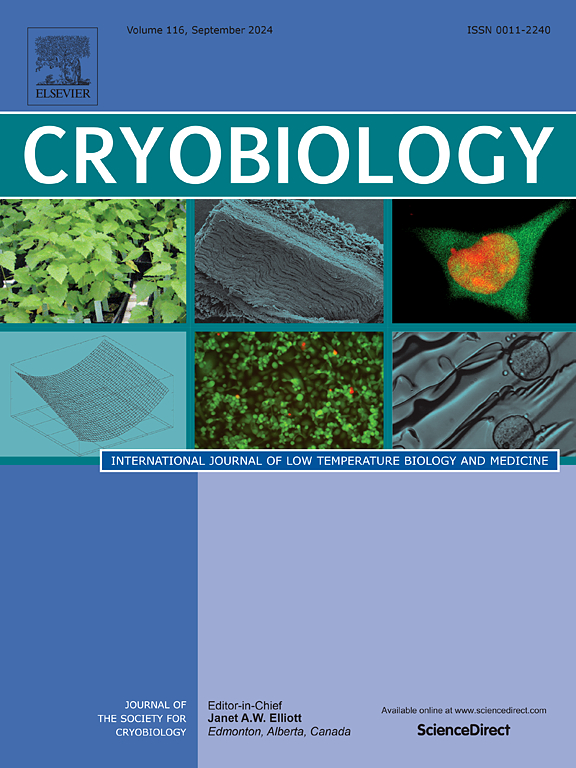外源性乳铁蛋白和磷酸甘油酸突变酶2对野生反刍动物附睾/射精精子和睾丸组织冷冻保存的影响。
IF 2.3
3区 生物学
Q2 BIOLOGY
引用次数: 0
摘要
从野生反刍动物附睾尾部采集的精子比射精精子具有更强的抗冻性。本研究考察了野生反刍动物附睾精子中丰富的乳铁蛋白(LF)和磷酸甘油酸突变酶2 (PGAM2)作为伊比利亚野山羊和摩富龙精子扩展剂添加剂的作用。此外,将LF添加到玻璃化培养基中,以确定其在睾丸组织冷冻保存期间是否也提供保护。在繁殖季节,从野山羊(n=13)和麋鹿(n=8)的死后提取附睾精子和睾丸样本。采用经直肠超声引导按摩技术收集两种动物的射精(各10只)。每个样品取四等分,用相应的冷冻扩展剂稀释,分别进行对照、LF (100 μg/ml)、PGAM2 (25 μg/ml)和LF+PGAM2处理。将睾丸组织切成小块,在含或不含LF的培养基中通过针浸玻璃化冷冻保存。体内受精能力评估使用冻融射精的精子从ibexx。添加LF或PGAM2及其组合对冻融后精子的任何变量均无有益或有害影响。人工授精的结果表明,对照ibex的受精率为62.5%,而经LF处理的精子受精率为20% (p = 0.06),表明LF可能对其受精率有负面影响。用LF玻璃化加热的样品中,长形精子和摩弗龙睾丸精子的存活率更高(p < 0.05)。因此,用LF和/或PGAM2补充射精精子可以提高冷冻解冻后精子质量的假设不成立。然而,在玻璃化摩弗龙睾丸组织时,LF似乎是一种合适的添加剂。本文章由计算机程序翻译,如有差异,请以英文原文为准。
Effect of exogenous lactoferrin and phosphoglycerate mutase 2 on the cryopreservation of wild ruminant epididymal/ejaculated sperm and testicular tissue
Spermatozoa collected from the cauda epididymis of wild ruminants are more cryoresistant than are ejaculated spermatozoa. This work examines the effects of lactoferrin (LF) and phosphoglycerate mutase 2 (PGAM2), which are abundant in the epididymal sperm of wild ruminants, as additives in Iberian ibex and mouflon sperm extenders. In addition, LF was added to a vitrification medium to determine whether it also provided protection during the cryopreservation of testicular tissue. Epididymal sperm samples and testes were recovered post-mortem from ibexes (n = 13) and mouflons (n = 8) during the breeding season. Ejaculates were collected from both species (n = 10 each) using the transrectal ultrasound-guided massage technique. Four aliquots were taken from each sample, diluted in the appropriate freezing extender for each species, and subjected to the following treatments: control, LF (100 μg/ml), PGAM2 (25 μg/ml), and LF + PGAM2. Testicular tissue was cut into small pieces and cryopreserved by needle-immersed vitrification in a medium with or without LF. In vivo fertilization capacity was assessed using frozen-thawed ejaculated sperm from the ibexes. Supplementation of extenders with LF or PGAM2, and their combination, had no beneficial or harmful effect on any sperm variable after freezing-thawing. Artificial insemination of ibexes showed that the fertility rate in controls was 62.5 %, but this fell to 20 % in females inseminated with sperm treated with LF (p = 0.06), suggesting a putative negative effect of LF on fertility. The viability of elongated spermatids and spermatozoa from mouflon testes was greater (p < 0.05) in samples that were vitrified-warmed with LF. Thus, the hypothesis that supplementing ejaculated sperm with LF and/or PGAM2 improves sperm quality after freeze-thawing was not upheld. However, LF would seem an appropriate additive when vitrifying mouflon testicular tissue.
求助全文
通过发布文献求助,成功后即可免费获取论文全文。
去求助
来源期刊

Cryobiology
生物-生理学
CiteScore
5.40
自引率
7.40%
发文量
71
审稿时长
56 days
期刊介绍:
Cryobiology: International Journal of Low Temperature Biology and Medicine publishes research articles on all aspects of low temperature biology and medicine.
Research Areas include:
• Cryoprotective additives and their pharmacological actions
• Cryosurgery
• Freeze-drying
• Freezing
• Frost hardiness in plants
• Hibernation
• Hypothermia
• Medical applications of reduced temperature
• Perfusion of organs
• All pertinent methodologies
Cryobiology is the official journal of the Society for Cryobiology.
 求助内容:
求助内容: 应助结果提醒方式:
应助结果提醒方式:


